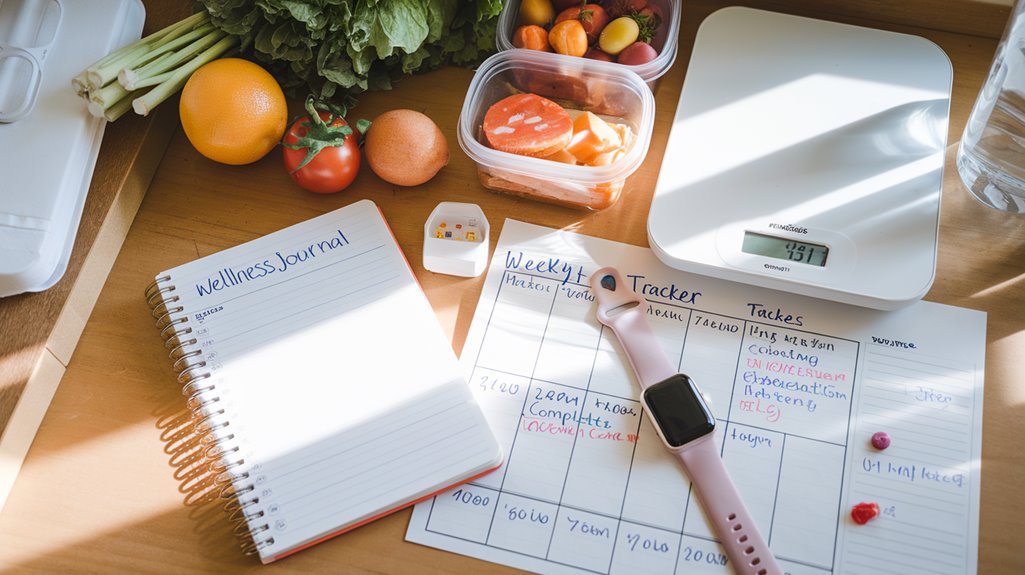Get ready for life after Mounjaro with insider tips on managing weight, hunger, and lifestyle changes your doctor forgot to mention.

After stopping Mounjaro, you'll likely experience significant physical changes, including an average 11.5% weight regain and increased hunger as GLP-1 levels decrease. You'll need to implement strategic lifestyle modifications, including a balanced diet with lean proteins and fiber-rich foods, plus 150 minutes of weekly exercise. Managing portion control, tracking progress, and building a support system become essential components. Understanding these changes and having an action plan will help you maintain your progress through the shift.
While Mounjaro has demonstrated remarkable effectiveness for weight loss during treatment, clinical trials reveal a more complex reality after discontinuation. You'll likely face a significant challenge: patients who stop taking Mounjaro typically regain 11.5% of their body weight, leaving them with just a 9.5% total weight reduction from their starting point.
The science behind this regain is straightforward. When you stop taking Mounjaro, your GLP-1 levels decrease, triggering increased hunger and calorie intake. SURMOUNT-4 trial data shows that patients who discontinued the medication regained 15% of their weight, while those who continued lost an additional 7%. You're fundamentally fighting against your body's natural response to reduced GLP-1 levels. Making sustainable lifestyle changes during treatment is crucial for maintaining weight loss results.
This pattern isn't unique to Mounjaro – it's consistent with the understanding that obesity requires chronic management, similar to other long-term health conditions.

To maintain the weight loss achieved through Mounjaro treatment, you'll need to implement specific lifestyle modifications that target multiple aspects of health management. Start by restructuring your nutrition with a balanced diet rich in lean proteins, complex carbohydrates, and dietary fiber while limiting processed foods and excess sugars. Weekly weight loss of one to two pounds is considered a healthy and sustainable target.
Your exercise regimen should include both cardiovascular activities and resistance training, aiming for 150 minutes of moderate exercise weekly. Begin with manageable intensities and gradually progress as your fitness improves. Remember to incorporate flexibility exercises to support overall physical well-being.
Develop stress management techniques through mindfulness practices, and build a strong support network to maintain motivation. Set realistic, measurable goals and celebrate non-scale victories along your journey. Regular check-ups with healthcare providers will help you adjust your maintenance strategy as needed, ensuring you're on track with your long-term success plan.
Building on your established lifestyle changes, managing hunger without medication represents a significant aspect of post-Mounjaro success. Your body's natural hunger signals will gradually return, making it essential to implement effective appetite management strategies. Focus on consuming smaller, more frequent meals rich in protein and fiber while maintaining proper hydration levels throughout the day. Consider incorporating beta-glucan rich foods like oats, barley, and rye to promote sustained weight loss.
These strategies, combined with portion control and careful meal planning, will help you maintain the appetite regulation you've developed during treatment while supporting your long-term weight management goals.

Establishing a robust support system proves essential for maintaining weight loss achievements after Mounjaro treatment. You'll need to schedule regular check-ins with your healthcare providers to monitor your progress and adjust your post-medication strategy effectively. Doctors recommend maintaining a 600-calorie deficit daily to continue your weight management success after treatment.
Build a network of support by involving family members, friends, and professional experts who can help you stay accountable. Consider joining support groups where you can share experiences and strategies with others who've completed Mounjaro treatment. Your healthcare team, including dietitians and personal trainers, can provide specialized guidance during this phase.
Set realistic goals and track your progress through both scale and non-scale victories. Keep a journal to monitor your food intake, exercise routines, and emotional patterns. This documentation will help you identify triggers and maintain your progress.
Focus on implementing sustainable lifestyle changes, including a balanced diet rich in whole foods and consistent physical activity, to support your long-term success without medication.
You'll need to prioritize lean proteins like skinless poultry and fish, aiming for 0.75-1.6 grams per kilogram of body weight to maintain muscle mass and satiety. Your meals should emphasize fiber-rich foods such as apples, carrots, and brussels sprouts, which help regulate calorie intake and reduce obesity risk. By combining protein-rich foods with high-fiber options at each meal, you're creating a foundation for sustainable weight management beyond Mounjaro treatment. To maintain your success, plan to eat smaller, frequent meals throughout the day to help manage potential digestive issues and maintain steady energy levels.
Once you've completed Mounjaro treatment, maintaining adequate protein intake becomes vital for preserving muscle mass and managing hunger. Focus on selecting nutrient-dense protein sources that are easy to digest and incorporate them strategically throughout your day.
Breaking larger portions into smaller, frequent meals can help you maintain consistent protein intake throughout the day. Remember to pair your protein choices with plenty of vegetables and whole grains while staying hydrated to support your post-treatment nutrition goals.
While moving away from Mounjaro treatment, prioritizing fiber-rich foods becomes essential for maintaining weight management success. Start with easily digestible options like cooked vegetables and bananas, then gradually incorporate heartier choices such as kale, broccoli, and cauliflower into your meals. Following the Mediterranean diet approach can help you maintain steady blood sugar levels while transitioning off medication.
Focus on whole grains like quinoa and brown rice, complemented by protein-rich legumes such as lentils and beans. These foods help maintain satiety and stabilize blood sugar levels. For ideal digestive comfort, pair your fiber-rich choices with fermented foods like yogurt or kefir.
If you experience gastrointestinal sensitivity, begin with gentler options like melons and well-cooked vegetables. As your body adjusts, slowly increase your fiber intake through fruits like apples, raspberries, and oranges. This measured approach helps prevent digestive discomfort while supporting your weight management goals.

After discontinuing Mounjaro, patients typically experience several significant physical changes that require careful monitoring and management. Your body will begin adjusting to the absence of tirzepatide's effects, potentially leading to shifts in appetite, metabolism, and digestive patterns. You'll likely notice increased hunger signals as your GLP-1 and GIP levels naturally decrease, which can make portion control more challenging. Many people experience significant weight regain without maintaining proper lifestyle modifications.
Understanding these physical changes allows you to respond proactively. If you experience severe digestive issues or dramatic appetite increases, consult your healthcare provider for personalized guidance and support strategies.

Creating a personalized post-Mounjaro action plan can greatly improve your chances of maintaining weight loss and health benefits achieved during treatment. Start by establishing clear, achievable goals for both diet and exercise, focusing on sustainable habits rather than quick fixes.
Your plan should include specific dietary strategies, such as increasing protein and fiber intake while dividing your daily calories into smaller, frequent meals. You'll need to schedule regular exercise sessions that combine both aerobic activities and strength training, gradually increasing intensity as your fitness improves. Since it can take up to a year to see full weight loss results with Mounjaro, your post-medication plan should span at least that duration.
Don't forget to address the psychological aspects of weight management. Include strategies for managing emotional eating and stress, such as mindful eating practices or regular counseling sessions. Set up a monitoring system to track your progress, including regular weigh-ins and health check-ups. Consider working with a registered dietitian to fine-tune your nutrition plan and guarantee you're meeting your nutritional needs.
Your success after Mounjaro depends on implementing proven lifestyle changes, maintaining consistent habits, and following evidence-based nutritional guidelines. You'll need to monitor your hunger signals, adjust your eating patterns, and stay connected with healthcare providers who understand post-GLP-1 management. By establishing these foundational practices now, you're positioning yourself for sustainable weight maintenance and long-term metabolic health after treatment ends.